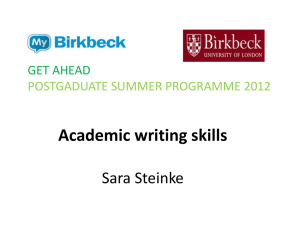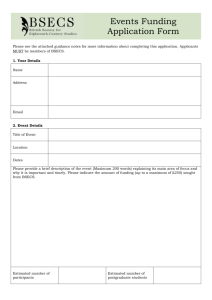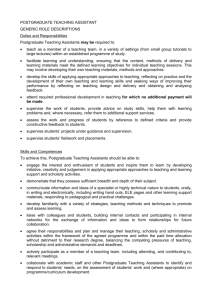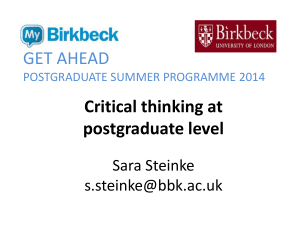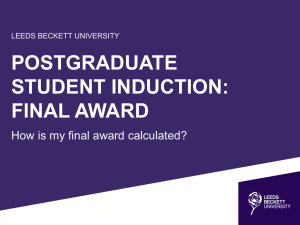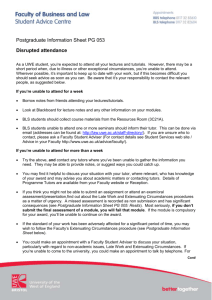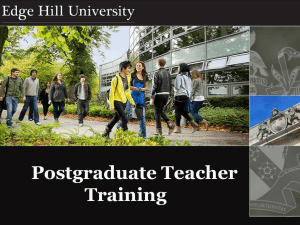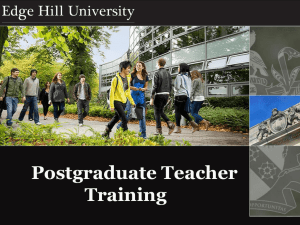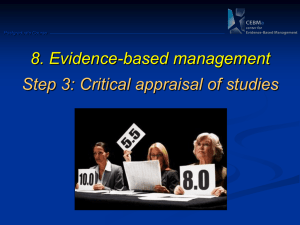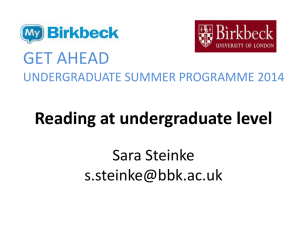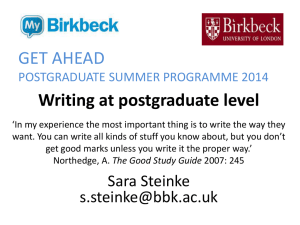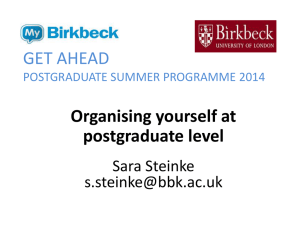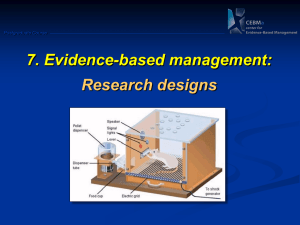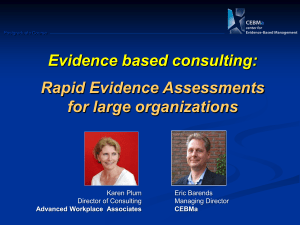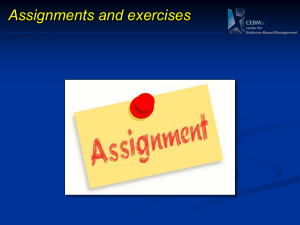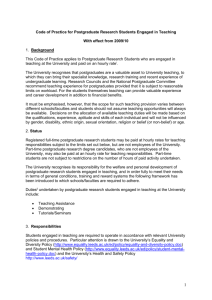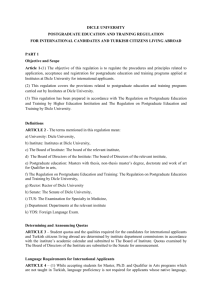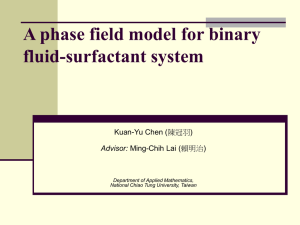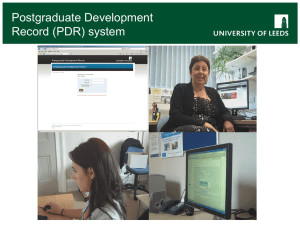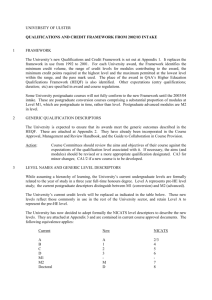Reading at postgraduate level
advertisement
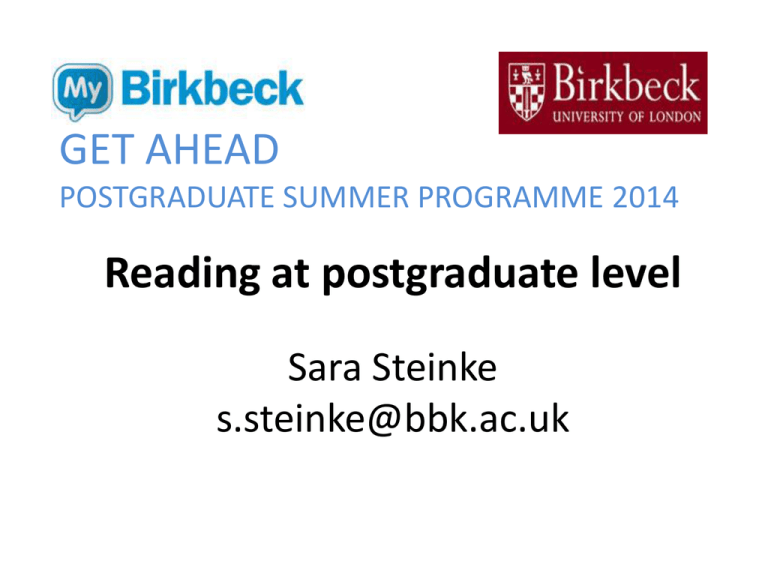
GET AHEAD POSTGRADUATE SUMMER PROGRAMME 2014 Reading at postgraduate level Sara Steinke s.steinke@bbk.ac.uk Aims of the session • To extend your reading and note making skills - to cope with the large amount of reading expected at postgraduate level - to deal with the more complex reading expected at postgraduate level • To understand the link between critical reading and note making skills and higher order critical thinking skills for postgraduate study • Common problems students encounter when reading for academic purposes • Are you a smart reader? • Reading skills for Writers are not postgraduate study authorities. They are participants in a public • Importance of reading skills for critical exchange of views. Be thinking critical of their work. Common difficulties with reading for academic purposes Which of them apply to you? 1. I read the words on the page but am not taking them in. 2. I spend too much or too little time on the reading. 3. I have difficulty expressing what I have read in my own words. 4. I simply do not understand the material. 5. I find the language used too complicated. 6. I can not remember everything I read. 7. I find the amount of reading overwhelming. • Selective • Mapped • Achievable • Relevant • Time-limited Retain more Read less Read more quickly Active Reading Academic reading Reader is: Non academic reading Reader is: • active • passive • selective and interacts with the reading material • reads from page one till the end • has a particular question in mind • re-reads with a purpose • does not ask questions • expects the author to guide them through the narrative How to organise your reading Five stage reading process: the SQ3R technique • Survey, Scan and Skim your sources in order to select the most relevant ones • Question: ask yourself what you want to get from the book • Read: analyse the argument • Recall: fully understand the author’s argument • Review: pause and take notes Survey • Aim: to get an overall idea of what the text is about • How to survey a book: – read the title; look at the book’s contents and index – search the author’s institutional affiliation; who they cite in their bibliographies – bibliographies/reference pages are shortcuts/cues in making literature choices; scan the bibliography/ references – bibliography: includes all work consulted whether actually cited or not – references: includes only cited/paraphrased work Scanning • Aim: to read quickly a text to get particular information • How to scan a book: 7 steps to follow (Levin, 2004: 49) – ‘Remind yourself of your key terms’ – ‘Scan the contents page’ – ‘Scan the index page’ – ‘More bookmarks’ – ‘Scan the whole book’ – ‘Photocopy the most important bits’ – ‘Organise and apply your results’ Skimming • Aim: to quickly go through the text to get a general idea • How to skim an article/book: – read the abstract/summary (typically only available for journal articles, some book chapters) – read the introduction and conclusion – read the text according to subheadings and first/last paragraphs – look at the first and last sentence of each paragraph Question • Aim: to frame queries about the book/article; ask what are the key concepts to understand; how they relate to each other; which are the central arguments that need to be mastered • How to question a book/article: – what do I want to know? – where can I find it in the book? Read • Aim: to work through part of the text methodologically from beginning to end without making notes; concentrate on understanding what the author is saying; essential to critical thinking • How to read a book/article: – – does the book contain the information I need? use critical reading strategy Recall • Aim: to ask what have I learned?; essential for memory skills • How to recall a book/article: – pause in your reading to summarise your understanding – make notes of the author’s main points Review • Aim: to ask have I found what I wanted? What are the next steps I should take? What further texts should I look at? • How to review a book/article: – compare what you have recalled with the text – – itself, look for important points you missed check whether you now have answers to queries defined at the question stage ensure your notes accurately capture what the author says Reading skills – reading decelerators • Sub-vocalisation • Finger-pointing • Back-tracking • Interruptions • Low light and discomfort • Fatigue • Poor vocabulary or comprehension • Reading session too long Reading skills – reading accelerators • Eye movement : from left to right and from top to down Our eyes move, pause and recognise characters. Every time the eye stops it is called fixation, the period in which reading matter is recognised, understood and stored in memory. • If you have the habit of fixing your eye on every word, try to fix on every other word or every third or fourth word Reading skills – speed and comprehension tips • Read at a speed that is comfortable for you • If you can read extremely fast, you might read more slowly to enjoy the text (novels) or understand it better (academic sources) • Practice using different reading speeds • Practice reading to improve your reading speed • Focus on attention and concentration • Grasp overall concepts, rather than attempting to understand every detail Reading – recap Can you: select and use different reading strategies (e.g. skim, scan, in-depth)? think about what you need to find out before you start reading (are you reading to verify facts, to understand a subject in general or to analyse a particular argument)? critically evaluate reading? deal with new vocabulary? Useful sources (for reading) Cottrell, S. (2008) The Study Skills Handbook, 3rd ed., (London, Macmillan) Chapter 6 ‘Research skills’ pp.111-136 Northedge, A. (2005) The Good Study Guide (Milton Keynes, Open University Press) chapter 5 ‘Reading’ pp.101-128 Wallace, M. & Wray, A. (2011) Critical Reading and Writing for Postgraduates, 2nd ed., (London, Sage) http://www.bbk.ac.uk/mybirkbeck/get-ahead-stay-ahead/skills/reading http://www.palgrave.com/skills4study/studyskills/learning/reading.asp • Common problems students encounter when note making for academic purposes • Note making skills for postgraduate study linear notes, mind mapping • Importance of note Active reading (SQ3R) and making for critical effective note making go thinking hand-in-hand Common difficulties with notes Which of them apply to you? 1. I try to take down everything that is said/on the PowerPoint presentation in lectures. 1. I am unsure what the purpose of note-taking is. 2. I am uncertain about how many notes to take. 3. I am unsure what to make notes on. 4. I do not take time to organise my notes so that I can retrieve them later on. 5. I only know one way for note-taking. Techniques for linear, sequential notes • Make headings and subheadings • List key words • Number the points • Underline, colour, use capital letters for emphasis • Use abbreviations. Examples: = for equal, < less than, > more than, increase, decrease, re regarding, cf compared with • Only use one side of a page in case you want to add more • Note name of authors you want/need to read in margin Linear notes Advantages • If an article or lecture is well structured, your notes will be well structured too • Look at the opening sentence of an article, then the first sentence in each paragraph • In a lecture the tutor will emphasise at the beginning the key points, concepts or themes they will talk about • It is the easiest method when you do not know anything, or very little, about the subject Disadvantages • Your notes are probably too wordy and messy • The temptation is to scribble down everything the lecturer says. Until you have some experience of the subject, it is difficult to decide what is and what is not important. Your notes from reading may be too copious and you may be copying whole sentences. • Linear notes do not give you a good overview. You might end up with thick folders of detailed notes but cannot get a sense of the essence of what you are studying. Techniques for radial, concept notes or mind maps • Turn the paper sideways, A3 landscape is best • Write the topic in the centre of the page • Write related ideas around this centre • Add secondary ideas to the main ideas • Link up these ideas to show relationships • Use colours, different line thickness, symbols, pictures • Add details to points as you go along Mind Maps Advantages • Quicker to write and read • Gives an excellent overview of the topic • Forces you to be brief • Relationship between ideas becomes obvious • Can add more details around the map at a later stage • Visually, more easily remembered than linear, written notes Disadvantages • More difficult to make when you are new to the subject • May need to make a map of a map soon after reading or the lecture to do some tidying up • Making radial or concept notes takes some practice before you can do them easily and efficiently Note making skills – from your reading • Read with a question in your mind (see SQ3R reading strategy) • Look carefully at the content and index. Is it relevant to your question? • Note: Author, title and publication details of book/article, the facts, the theories, other people’s opinions, definitions, quotations for later use? (write down page number). • Never copy directly from a book - write it in your own words. • At the end of each paragraph or section stop reading, summarise in your head what you just read and make notes. • First sentence of a paragraph - called the topic sentence and sometimes the last sentence, should give you a good idea what the paragraph is all about. Note making skills – from your lectures • Preparation begins before a lecture • Read recommended reading before the lecture • Print out the lecture notes, slides or hand-outs before the lecture • Identify/anticipate main points and structure of lecture • Recognise when lecturer is digressing or getting into too much detail - do not bother to make notes • Listen/watch for verbal transition cues and nonverbal signs from your lecturer Note making skills – transition cues Lecturers/writers use the signposts to signal how their points relate to each other. Some examples: • To tell the listener/reader that you are providing additional information: also, furthermore, besides, equally important, moreover • To move to specific examples: as an illustration, particularly, for instance, specifically, notably, to demonstrate • To clarify a point: in other words, that is to say, put another way, in this case Note making skills – more transition cues • To emphasise a point: as a matter of fact, obviously, in any case, indeed, most importantly, undoubtedly • To signal that you are about to begin or end a digression: incidentally, by the way, to change the subject, anyway, as I was saying, at any rate, to return to the subject • To state an effect or result: as a result, because of this, for this reason, consequently, • To summarise what you have already said: all in all, overall, as I mentioned, by and large, briefly, given these facts, in short • To introduce the conclusion: finally, in short, in summary, in conclusion, on the whole Condensing notes • ‘Boil’ notes down to essential information. This is often easier to do a few weeks later, because your understanding of the subject has increased. You can see more clearly what is important information and what is not. • Note gaps in your knowledge, any confusion and contradictions • Move from linear notes to conceptual notes (charts, radial outlines, mind maps) Organising and storing your notes • By systematic from the beginning • Make sure you can (re)read them before filing them away - but do not rewrite them ‘neatly’ • Condensed notes can be copied and filed in at least two different ways: - chronological order (as you go along) - topic order (e.g. in anticipation of an assignment) - personal interest (for your own research later?) • Write subject clearly in top right hand corner; number pages; colour code them Importance of note making for critical thinking • To focus attention on what you are reading • To help you make sense of what you read/hear • To help you remember the key points • To alert you to what you have not understood • To help you when you are planning an assignment • To help you when you are revising for exams • To enable you to distinguish between facts, opinion and evidence Note making – recap Can you: make effective notes when reading? make effective notes when listening (e.g. during lectures)? use more than one note making technique? do you have a way of organising your notes? Useful sources (for note making) Cottrell, S. (2008) The Study Skills Handbook, 3rd ed., (London, Macmillan) chapter 6 ‘Research skills’ pp.111-136 Northedge, A. (2005) The Good Study Guide (Milton Keynes, Open University Press) chapter 6 ‘Making notes’ pp.128-156 Buzan T. (rev. 2003) Use Your Head (London, BBC) Buzan, T. & B. (rev. 2006) The Mind Map Book (London, BBC ) Buzan T. (2007) The Buzan Study Skills Handbook (London, BBC) http://www.bbk.ac.uk/mybirkbeck/get-ahead-stay ahead/skills/notetaking http://www.mind-mapping.co.uk/ http://www.thinkbuzan.com/ http://www.mindmapinspiration.co.uk/ Recap of the session • To extend your reading and note making skills - to cope with the large amount of reading expected at postgraduate level - to deal with the more complex reading expected at postgraduate level • To understand the link between critical reading and note making skills and higher order critical thinking skills for postgraduate study Next session • Wednesday 27 August, 6pm-7.30pm, room 421 • Writing at postgraduate level – what makes English academic – style and conventions of academic writing – the writing process – developing your academic writing skills for postgraduate study
